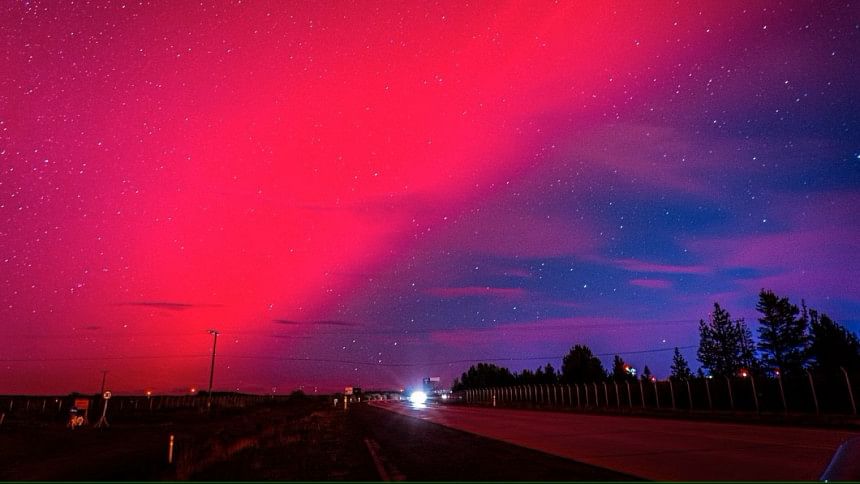Solar storm and aurora: A dazzling display of colourful lights

Thirty-three days after the breathtaking total solar eclipse that swept through a vast swath of North America on April 8, the Sun has produced yet another dazzling celestial drama. This time it is a cosmic extravaganza of colourful lights that painted the skies across the Northern Hemisphere during the early hours of the May 11 weekend with vibrant hues of pink, green, and purple. This rare show of lights is referred to as aurora, after the Roman goddess of the dawn. In the United States, it was seen by millions of people as far south as Florida and Southern California.
What causes an aurora? The root cause of an aurora is a solar storm, a dramatic blast of electromagnetic radiation from the Sun. The storm consists of solar flares, which are the most violent form of solar activity. A flare occurs when magnetic energy that has built up in sunspots―areas on the surface of the Sun that appear dark because they are relatively cooler than other parts of the Sun's surface―is suddenly released. Hence, solar storms are also known as geomagnetic storms.
Flares are most common when numerous sunspots are visible on the solar surface. Near large sunspots, about a hundred flares occur each day. The number of flares also depends on the intensity of solar activity, which goes through a high-low cycle over a period of 11 years. The current cycle that began five years ago is predicted to peak in an activity called a solar maximum, in July 2025.

The intensity of solar activity is measured on a five-level scale, ranging from G1 (minor) to G5 (extreme), with the recent one labelled G4 (severe). It is expected to continue for a few more days, albeit with intensity G3 (strong) or G2 (moderate).
The vast amounts of energy released by a typical solar flare across the entire electromagnetic spectrum heats nearby material, thereby launching a colossal amount of plasma―a hot soup of charged particles and magnetic field―from the Sun's corona, or upper atmosphere. The phenomenon is termed coronal mass ejections (CMEs). As the flare races towards Earth, its electromagnetic radiation and the CME rip through the upper atmosphere and ionise neutral atoms by removing electrons from them.
Occasionally, charged particles flowing outwards from a CME escape into the solar winds, which are also a stream of charged particles released from the Sun's corona. The effects of these particles on the atmosphere of a planet depend largely on whether the planet has a strong enough magnetic field to divert the charged particles in the solar wind.
On planets like Mars and Venus that do not have strong magnetic fields, charged particles in the solar wind can directly impact the surface of the atmosphere. Fortunately, Earth's strong magnetic field creates a magnetosphere that acts like a protective bubble surrounding our planet. The magnetosphere deflects most of the charged particles around our planet, thus protecting us from their harmful effects.
Oftentimes the magnetosphere allows a few of the charged particles in the solar wind to get through, especially near the magnetic poles that are relatively close—about 10 degrees—to the geographic poles. Once the charged particles penetrate the magnetosphere, they follow the magnetic field all the way down to the Earth's atmosphere, where collision with atoms and molecules in the atmosphere sends them into an excited state. The charged particles quickly de-excite emitting light that creates the colourful display of the aurora dancing around the Earth's magnetic poles. In the Northern Hemisphere, the aurora is often called Aurora borealis, or Northern Lights, and is best viewed at high latitudes. In the Southern Hemisphere, it is called Aurora australis, or Southern Lights.
The energy released by the solar storm can cripple Earth's technological infrastructure, mess up satellites, radio communications, internet, navigation signals from GPS satellites, halt aviation and severely damage electric power grids. If there is a direct hit, the impact could be catastrophic, costing trillions of dollars in damage to our economic and high-tech infrastructures affecting millions of people. However, today there are systems in place to minimise the impact.

Two recent massive solar storms that pummelled the Earth are the Great Aurora of March 1989 and the Halloween Sun Storm of October 2003. The storm of 1989 blacked out lights for millions of people in Québec, Canada, whereas the Halloween storm disabled many satellites and damaged instruments on a Mars orbiter.
The largest solar storm on record occurred in 1859. It was dubbed the Carrington Event, named after the British astronomer Richard Carrington, the discoverer of solar flares. It bathed "two-thirds of the Earth's skies in a blood-red aurora a night later, and crippled all of global navigation and global communication, such as it was at that time."
Finally, doomsday prophets are worried that solar storms are an omen for the end of the world. They will, however, be disappointed because the thought of a solar Armageddon is far-fetched. This is because the thousands of miles of thick magnetosphere 40,000 miles above will not fail us. Besides, much of the CME is faced away from Earth, and consequently the danger is lessened. In fact, other than the usual inconveniences caused by solar storms, we will always be entertained by a brilliant show of the auroras. Nonetheless, in the future, we can expect a monstrous solar storm that would make the Carrington Event look like a rain shower.
Dr Quamrul Haider is professor emeritus at Fordham University in New York, US.
Views expressed in this article are the author's own.
Follow The Daily Star Opinion on Facebook for the latest opinions, commentaries and analyses by experts and professionals. To contribute your article or letter to The Daily Star Opinion, see our guidelines for submission.

 For all latest news, follow The Daily Star's Google News channel.
For all latest news, follow The Daily Star's Google News channel. 








Comments